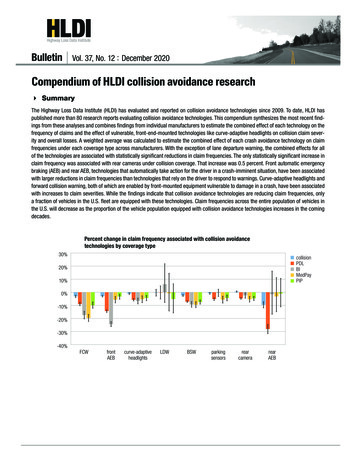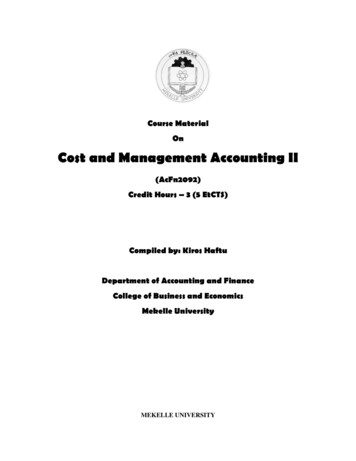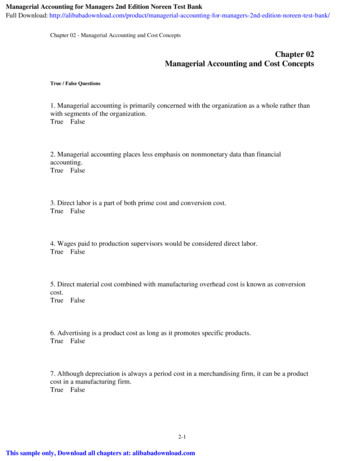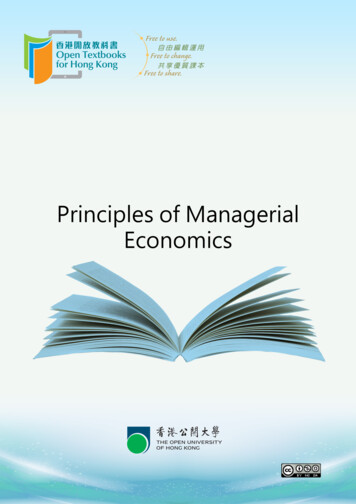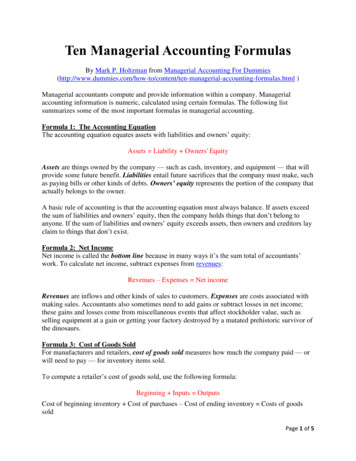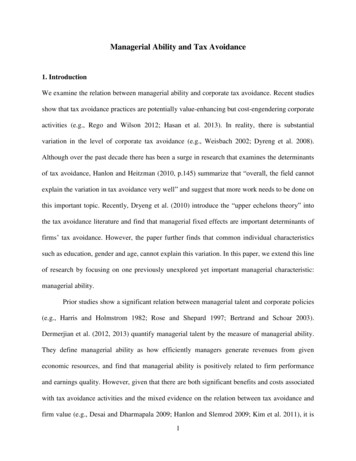
Transcription
Managerial Ability and Tax Avoidance1. IntroductionWe examine the relation between managerial ability and corporate tax avoidance. Recent studiesshow that tax avoidance practices are potentially value-enhancing but cost-engendering corporateactivities (e.g., Rego and Wilson 2012; Hasan et al. 2013). In reality, there is substantialvariation in the level of corporate tax avoidance (e.g., Weisbach 2002; Dyreng et al. 2008).Although over the past decade there has been a surge in research that examines the determinantsof tax avoidance, Hanlon and Heitzman (2010, p.145) summarize that “overall, the field cannotexplain the variation in tax avoidance very well” and suggest that more work needs to be done onthis important topic. Recently, Dryeng et al. (2010) introduce the “upper echelons theory” intothe tax avoidance literature and find that managerial fixed effects are important determinants offirms’ tax avoidance. However, the paper further finds that common individual characteristicssuch as education, gender and age, cannot explain this variation. In this paper, we extend this lineof research by focusing on one previously unexplored yet important managerial characteristic:managerial ability.Prior studies show a significant relation between managerial talent and corporate policies(e.g., Harris and Holmstrom 1982; Rose and Shepard 1997; Bertrand and Schoar 2003).Dermerjian et al. (2012, 2013) quantify managerial talent by the measure of managerial ability.They define managerial ability as how efficiently managers generate revenues from giveneconomic resources, and find that managerial ability is positively related to firm performanceand earnings quality. However, given that there are both significant benefits and costs associatedwith tax avoidance activities and the mixed evidence on the relation between tax avoidance andfirm value (e.g., Desai and Dharmapala 2009; Hanlon and Slemrod 2009; Kim et al. 2011), it is1
unclear whether managers with superior abilities are associated with more or less tax avoidanceactivities.As is the case with other investment opportunities, tax avoidance provides economicbenefits, which in this case are primarily from tax savings. For example, Mills et al. (1998) findthat an additional 1 investment in tax planning results in a 4 reduction in tax liabilities.Scholes et al. (2009) conclude that potential tax savings from aggressive avoidance strategiescould be economically large. Dyreng et al. (2013) find that the use of Delaware subsidies asdomestic tax havens, on average, increases net income by 1.0 - 1.5%. Thus, if more ablemanagers are better at generating revenues from given economic resources, then by the sametoken, we should expect that superior managers are more knowledgeable at exploring taxavoidance opportunities to increase firm value.However, tax avoidance also consumes valuable resources. Prior studies show that taxavoidance activities are necessarily complex, obfuscated, and opaque, and are associated withsignificant costs (e.g., Desai and Dharmapala 2006; Balakrishnan et al. 2012; Hasan et al. 2013).Direct costs include tax planning, litigation and other expenses of mounting a defense against taxauthority challenges, back taxes, and potentially hefty penalties and fines imposed by taxauthorities. Indirect costs include political costs, potential damage to the firm’s reputation, andcost of debt capital (e.g., Hanlon and Slemrod 2009; Graham et al. 2013; Hasan et al. 2013).Another type of cost that is particularly important for this study is the opportunity cost ofmanagerial efforts. Rational managers should devote their time to projects that offer the highestpositive net present value. When a manager’s opportunity cost increases, the incremental valueadded by tax avoidance is reduced and tax avoidance becomes a less attractive investment, given2
other things equal. Therefore, we should expect that firms with more able managers to engageless in tax avoidance activities.Using a sample of 42,340 firm-year observations for 7,001 U.S. firms over the period1988 through 2009, we empirically examine the relation between managerial ability (asmeasured by Demerjian et al. (2012, 2013)) and tax avoidance. Given that we are interested inbroad tax avoidance strategies that could reduce the firm’s taxes relative to its pretax income,following Dyreng et al. (2008), Hope et al. (2013), among others, we use the effective tax rate(ETR) and the cash effective tax rate (CETR) as our primary measures of tax avoidance.We find a negative and significant relation between managerial ability and tax avoidanceafter controlling for firm-level factors that have been shown to impact tax avoidance in theliterature. Our results are robust to the inclusion of additional controls such as earnings quality,governance quality and equity incentives, and when we use alternative measures to proxy formanagerial ability (i.e., historical stock returns) and tax avoidance (i.e., three book-tax differencebased measures). Our results are also robust to the use of firm fixed-effect regressions to mitigateomitted variable bias, and when we use the Fama-MacBeth regression method to deal withpossible cross-sectional dependence of regression errors.Importantly, our findings are also economically meaningful. For instance, results fromour baseline regressions show that a one standard deviation increase of managerial ability score,on average, is associated with about 0.32% increase of ETR or 0.59% increase of CETR, whichtranslates to a 0.57 million increase in tax expense or 1.05 million increase in cash taxpayment each year. Overall, our results show that firms with managers that have superiorabilities are associated with lower levels of tax avoidance that are both statistically significantand economically meaningful.3
To mitigate endogeneity concerns, we employ a difference-in-differences approach usinginformation from CEO turnovers. Specifically, we identify a treatment sample of firms that priorto the turnover were managed by low-managerial ability CEOs but came under the managementof high-managerial ability CEOs subsequent to the turnover. We also construct a control sampleof firms that were managed by low-managerial ability CEOs and remained that way followingthe CEOs turnover. The difference-in-differences results show that a low-to-high managerialability switch leads to a significant reduction in the level of tax avoidance compared to a low-tolow managerial ability switch. Using a similar identification strategy, we further find that a highto-low managerial ability switch leads to a significant increase in the level of tax avoidancecompared to a high-to-high managerial ability switch. Thus, our two sets of results providestrong evidence of a negative and causal effect of managerial ability on tax avoidance.We further examine the relation between managerial ability and tax aggressiveness, themost extreme subset of tax avoidance that can be considered as “pushing the envelope of tax law”(Hanlon and Heitzman 2010, p. 137). We use tax sheltering probability (Wilson 2009), predictedtax reserve balance (Lisowsky et al. 2013), and the usage of international tax haven subsides(Dyreng et al. 2009) to capture tax aggressiveness that likely engenders greater risks and costs.We find consistent results that managerial ability is negatively and significantly associated withall these measures of tax aggressiveness.Prior studies show that tax aggressiveness is associated with higher likelihood of stockprice crash risk (Kim et al. 2011) and negative market reactions (Hanlon and Slemrod 2009). Ourfinding of the negative relation between managerial ability and tax aggressiveness suggests thatmore able managers engage less in such activities which could hurt shareholders’ value. It istherefore, interesting to examine if those firms that do engage in tax aggressive activities such as4
shelters, whether investors would value managerial ability when assessing the potential damagescaused by such behaviors. Our results from the cross-sectional analysis of the market reactions totax sheltering news indicate that investors consider managerial ability in a positive way whenreacting to tax sheltering news.Thus, our results provide support for the argument that because of their superior abilitiesto increase firm value through normal business operations, more able managers have lessincentives to engage in tax avoidance activities than less able managers. If this is the case, weshould observe that the negative relation is more evident for firms with lower managerial abilitybecause the opportunity costs of those managers are lower. To test our conjecture, we separatethe full sample into two groups: firms with high ability managers and those with low abilitymanagers based on the median value of managerial ability score. Consistent with ourexpectations, we find that the negative relation between managerial ability and tax avoidance forfirms with low managerial ability is more significant, both statistically and economically, thanthat for firms with high managerial ability.Finally, we examine the impact of governance on a firm’s tax avoidance behavior. Desaiand Dharmapala (2009) find that, on average, the effect of tax avoidance on firm value is notsignificant, but is significantly positive in well-governed firms. We therefore examine whetherthe identified negative relation between managerial ability and tax avoidance is conditional onthe quality of firm governance. Specifically, we separate the sample into two groups: firms withgood corporate governance and firms with weak corporate governance based on the medianvalues of various governance measures (e.g., G-index, institutional ownership, and analystcoverage). Our results show that there is no significantly different effect of managerial ability ontax avoidance between these two subsamples, indicating that managerial ability is an inherent5
individual characteristic that affects tax avoidance, and that it is not affected by firms’governance environment.Our paper contributes to the growing literature on corporate tax avoidance. We shed lighton this topic by examining the impact of managerial ability on firm’s tax avoidance. Given thatmanagerial ability is shown to increase firm value and that tax avoidance does not necessarilyincrease firm value, it is not a priori apparent what the relation is between managerial ability andtax avoidance. We contend that it is important that firms’ tax avoidance policies be viewed asinvestment decisions that provide economic benefits as well as consume resources. As such, wefurther contend that managers with greater ability are better able to convert firm resources intorevenue and thus, tax avoidance becomes a less attractive option because of the significant costsassociated with it. Our main result of a significant negative relation between managerial abilityand tax avoidance (as well as tax aggressiveness) provides support for these arguments andtherefore, furthers our understanding of the determinants of tax avoidance and extends thefindings of Dyreng et al. (2010).Our paper also contributes to the growing research on attributes of managers, particularlymanagerial ability. Recent studies find that managerial ability is an important factor whichaffects firm performance and corporate decisions such as earnings quality and managementearnings forecast (Baik et al. 2011; Demerjian et al. 2012, 2013). Our finding of a negativerelation between managerial ability and corporate tax avoidance is consistent with prior research(Baik et al. 2011; Demerjian et al. 2013) that shows a positive relation between managerialability and accounting quality. Our paper complements and extends this stream of literature.Furthermore, our findings, especially results on tax aggressiveness, have important public policyimplications for regulators, investors, and managerial labor markets.6
The rest of the paper proceeds as follows. Section 2 reviews the relevant literature anddevelops our hypotheses. Section 3 describes the data and methodology. Section 4 presents theresults. Section 5 concludes.2. Literature review and hypothesis development2.1 Manager-specific effects and managerial abilityMany studies of corporate decisions assume a neoclassical view of top managers asreplaceable agents whose idiosyncratic differences do not affect corporate outcomes (Weintraub,2002). Studies in strategic management come to a similar conclusion by arguing that managersare constrained to make homogenous decisions by the entrenched norms and culture (e.g.,Lieberson and O’Connor 1972; Hannan and Freeman 1977) or by the propensity to conform toexternal expectations of rationality by imitating other managers (e.g., Spender 1989; Hambrick etal. 1993; Chalmers and Godfrey 2004). In addition, the selection processes of top managersfurther limit heterogeneity (Hitt and Tyler 1991; DiMaggio and Powell 1983; Hambrick 2007).This homogeneity assumption, however, is not prevalent in the business press and amongmanagers themselves. They are often perceived, at least, to have their own styles. 1 Furthermore,the empirical evidence shows that there is a large proportion of heterogeneity in corporatestrategies that is left unexplained by firm- and industry-level factors (e.g., Bradley et al. 1984;Titman and Wessels 1988; and Smith and Watts 1992). In fact, managers are often faced withuncertain situations in which they have to make complicated decisions using complexinformation (Hambrick and Manson 1984; Hambrick 2007). They therefore interpret those1For example, Bertrand and Schoar (2003) cite John Reed’s quote on style “In the old days I would have said it wascapital, history, the name of the bank. Garbage—it’s about the guy at the top. I am very much a process person, abuilder. Sandy [Weil] is an acquirer. Just totally different.” Another article in a May 2001 issue of Business Weekcited in their study is the so called “The Koszlowski Method,” describing the aggressive acquisition style of DennisKoszlowski, the CEO of Tyco.7
situations and act on the basis of their experience, values and personalities, as suggested bybounded rationality (March and Simon 1958; Cyert and March 1963).Since the development of the “upper echelons theory” by Hambrick and Manson (1984),studies have begun to examine the idiosyncratic differences of top managers in making corporatepolicies and their effects on corporate performance. For example, Johnson et al. (1985) find thatthere are abnormal stock price changes around unexpected deaths of senior corporate executives.Bertrand and Schoar (2003) find that managerial fixed effects matter for a wide range ofcorporate decisions and explain a significant portion of the heterogeneity in investment, financialand organizational practices of firms. They refer to managers’ fixed effects as “style” and tie itback to managers’ age and education. Bamber et al. (2010) track managers across firms overtime and find that top executives have unique and significant influence on their firms’ voluntarydisclosure; they tie those idiosyncratic effects, or “style”, to the managers’ personal backgroundsand experiences such as finance, accounting, legal, age, and military experience.While prior research suggests that managerial-specific features (experience, education,age or style) significantly impact firm behavior and performance, few attempts to quantifymanagerial ability or talent. Ultimately, it can be thought of as how efficiently managers can turnresources (assets) into profits. One notable exception is the recent study by Demerjian et al.(2012). These authors propose a measure of managerial ability based on their efficiency ingenerating revenues and find that this manager-specific efficiency measure is strongly associatedwith manager fixed effects. Using this measure, Demerjian et al. (2013) examine its relation withearning quality and find that managerial ability is positively associated with earnings quality.They explain the finding as “superior managers are more knowledgeable of their business,8
leading to better judgments and estimates and, thus, higher quality earnings.” (Demerjian et al.2013, p. 463)Given that corporate tax policies could be very complex decisions, due in part to theincreasingly complex nature of large and diversified businesses and the likelihood of beingdetected, manager-specific effects could be important factors in understanding the variation ofcorporate tax decisions. In the next sub-section, we review related literatures in both the taxavoidance and managerial ability areas and propose our hypothesis.2.2 Managerial ability and tax avoidanceWhile the issue of tax avoidance has been studied extensively for individuals in publiceconomics (Slemrod and Yitzhaki 2002), the literature on corporate tax avoidance is relativelyyoung (e.g., Shevlin and Shackelford 2001; Shevlin 2007; Hanlon and Heitzman 2010). Inparticular, a few recent studies indicate that top managers influence firms’ decisions about taxpolicies (e.g., Dyreng et al. 2010; Armstrong et al. 2012; Rego and Wilson 2012; Chyz 2013).Among these studies, Dryeng et al. (2010) focus on the individual impact of top managers.Examining a group of executives that switch firms, they find that the top management team playsa significant role in determining tax avoidance that cannot be explained by firm characteristics.Although this study is an important first step in examining individual managers’ effects on taxavoidance, the authors are not able to explain the variation among managers’ individual effectsin that they find that common observable characteristics such as education, gender, age, andtenure are not associated with executives’ propensities to reduce taxes.We believe that studying the effect of managerial ability on their firms’ tax avoidancecould yield meaningful insights. Viewing tax avoidance decisions as investment options (e.g.,9
Mills et al. 1998), a rational manager should decide on the level of tax avoidance depending onwhether this particular investment generates positive incremental NPVs and how it compareswith their firms’ other investment opportunities.The conjecture that tax avoidance provides direct benefits is based on the intuition thattax avoidance produces tax savings. For instance, with a statutory tax rate of 35 percent, thefirm’s tax bill could be up to one-third of its firm’s pre-tax profits. Thus, potential tax savingsfrom aggressive avoidance strategies could be economically large. For example, Mills et al.(1998) find that an additional 1 investment in tax planning results in a 4 reduction in taxliabilities. Dyreng et al. (2013) find that the use of Delaware subsidizes as domestic tax havens,on average, increases net income of 1-1.5%. While, Bloomberg News reported that Googleavoided 2 billion in worldwide income taxes in 2011 by channeling 10 billion of revenue intoa Bermuda shell company.However, as with other investments, tax avoidance entails consumption of resources or attimes liabilities. Direct costs include tax planning costs, litigation and other expenses ofmounting a defense against tax authority challenges, back taxes, potentially hefty penalties andfines imposed by tax authorities, and more rigorous scrutiny from tax authorities in the long run(e.g., blacklisted by the IRS). Anecdotal evidence indicates that the direct costs alone could bequite substantial.2 There are indirect costs that include political costs, potential damage to thefirm’s reputation and significant agency costs. For example, Hanlon and Slemrod (2009) arguethat firms engaging in tax sheltering activities are being labeled as “poor corporate citizens.” Inresponding to the survey by Graham et al. (2013), 69% of top executives agree that potential2For example, GlaxoSmithKline P.L.C. settled with the IRS with a 3.4 billion payment for transfer pricingpractices that seek to avoid taxes (Wall Street Journal, 2006). AstraZeneca P.L.C. paid 1.1 billion to settle a similardispute with the IRS in 2011. Merck & Co. settled several disputed tax issues including its use of minority equityinterest financing transactions with the IRS in 2007 by paying a settlement amount of 2.3 billion including backtaxes, penalties, and interest.10
harm to their firms’ reputations is very important when deciding what tax planning strategies toimplement. Chen et al. (2010) find that family firms have lower levels of tax avoidance whencompared to their non-family counterparts, indicating that family owner-managers are willing toforego tax benefits to avoid the potential price discount. Khurana and Moser (2013) argue that iflong-term institutional investors anticipate a strong positive feedback effect between corporatetax avoidance and rent diversion, they might seek to constrain managers’ ability to avoid taxes.Hasan et al. (2013) find corporate tax avoidance is positively related to the cost of both publicand private debt.In sum, it is therefore possible that the combined costs could potentially offset the taxsavings from tax avoidance, and the substantial costs related with tax avoidance could explainthe mixed results of the relation between tax avoidance and firm value. For instance, Desai andDharmapala (2009) find a positive relation between tax avoidance and firm value for wellgoverned firms. Desai and Hines (2002) find a positive market reaction to announcements ofcorporate investment decisions. In contrast, Hanlon and Slemrod (2009) find a negative stockmarket reaction to news concerning company involvement in tax shelters. Kim et al. (2011) finda positive relation between tax avoidance and stock price crash risk.In the decision-making models of managers, there is also opportunity cost of their efforts.Rational managers should devote their time in projects that offer the highest positive net presentvalue. For example, more able managers who can turn resources into revenues more efficientlymay invest more of their effort in operations than in designing tax avoidance plans, all else equal.Aggressive tax planning could be complicated given that it could involve corporation with aforeign municipality, transfer pricing with a foreign subsidiary, management of corporate lifeinsurance, or cross-border dividend capture, as pointed out by Graham and Tucker (2005). In11
sum, we contend that although there are benefits to tax avoidance, because of the significantcosts associated with it both directly and indirectly, managers with superior ability will be lesslikely to pursue all potential tax avoidance strategies. The following equation summarizes howmanagerial ability impacts the net present value from tax planning of avoidance activities,including the other costs discussed above.NPV(TA)j. t PV j, t)–PV j,t)-PV( j,t)(1)Where NPV(TA)j.t is the incremental value added by tax avoidance by firm j at time t;PV j,t)policies; PV is the present value of all the tax savings as a consequence of today’s taxj,t)is the present value of all the costs including litigation costs andfines if detected, and reputation loss; lastly, PV( j,t)measures thepresent value of the managerial opportunity cost which is the potential value given up whenmanagers devote time and resources on tax avoidance. The last term of Equation (1) suggeststhat when a manager’s opportunity cost increases, the incremental value added by tax avoidancereduces and tax avoidance becomes a less attractive investment, given other things equal.In sum, Equation (1) suggests a negative relationship between managerial ability and taxavoidance, where firms with more able managers are likely to engage in less tax avoidancebecause they could devote their time to other investments which could lead to greater benefits.Our prediction on how managerial ability impacts tax avoidance should even hold whenmanagers are self-interested. The proposed negative relation between managerial ability and taxavoidance, therefore, should be robust even after we control for corporate governance and12
managerial equity incentives. Based on the discussion above, we formalize our main hypothesisas follows:H1: Managerial ability is negatively related to the level of corporate tax avoidance.3. Research design, sample selection and summary statistics3.1. Measures of managerial abilityFollowing Demerjian et al. (2013), we use Demerjian et al. (2012) measures as ourprimary proxies for managerial ability. Their estimation of managerial ability is a two-stageprocess that begins with the estimation of total firm efficiency using data envelopment analysis(DEA). According to Demerjian et al. (2012, p. 4), “DEA is a statistical procedure used toevaluate the relative efficiency of separable entities, termed ‘decision-making units (DMUs)’,where each DMU converts certain inputs (labor, capital, etc.) into outputs (revenue, income,etc.).”In their model, individual firms serve as the DMUs. Revenues represent outputs, andseven financial items (net property, plant, and equipment; net operating leases; net research anddevelopment costs; purchased goodwill; other intangible assets; cost of inventory; and selling,general, and administrative expenses) represent inputs. In the first stage, total firm efficiency isestimated through an optimization procedure that allows varying weights for each of the inputsand outputs. In the second stage, by regressing total firm efficiency on various companycharacteristics (i.e., size, market share, cash availability, life cycle, operational complexity, andforeign operations), total firm efficiency is decomposed into firm and managerial parts.3Demerjian et al. (2012) point out the DEA approach to calculate efficiency allowsefficiency to be calculated based on the practical optimum level rather than average performance.3Please see Demerjian et al. (2012) for more details.13
As such they contend that it is superior to other proxies (e.g., abnormal returns or performance,compensation, tenure, and media coverage) with respect to its association with managerial fixedeffects, price reactions to CEO turnover announcements, and subsequent performance ofcompanies with new CEOs. Nonetheless, we acknowledge that it is still subject to measurementerrors, mainly because the residuals from the second stage model may still contain omittedfactors that affect firm efficiency which cannot be attributed to management. In our robustnesschecks, we also use historical stock returns as an alternative measure of managerial ability.Demerjian et al. (2012) provide two measures of managerial ability. One is a continuousscore for managerial ability for each firm/year (MA score), the other is industry/year decilesranking for each firm/year (MA rank). In our empirical tests, we use both to triangulate ourfindings.3.2. Measures of tax avoidanceHanlon and Heitzman (2010, p.137) state that “if tax avoidance represents a continuum oftax planning strategies where something like municipal bond investments are at one end, thenterms such as ‘noncompliance,’ ‘evasion,’ ‘aggressiveness,’ and ‘sheltering’ would be closer tothe other end of the continuum.” Given our conceptual framework, we are interested in broad taxavoidance strategies that could reduce the firm’s taxes relative to its pretax income. FollowingDyreng et al. (2008) and Hope et al. (2013), we use two standard measures to capture broad taxavoidance. The first is the firm’s effective tax rate (ETR), the ratio of total tax expenses (totalcurrent tax expense plus deferred tax expense) over pretax income adjusted for special items.The second one is the firm’s cash effective tax rate (CETR), the ratio of cash tax paid over pretax14
income adjusted for special items. By definition, both measures imply that higher values implyless tax avoidance.Dyreng et al. (2008) point out that these two measures are appropriate measures of taxavoidance because they capture various objectives managers could have with regard to taxavoidance. To the extent that managers are concerned with reducing tax expenses for financialreporting purposes, ETR captures the executive’s incentives to affect this metric. While CETRcaptures managerial incentives to reduce the actual taxes paid. Therefore, we use ETR andCETR as our primary measures of tax avoidance.However, it should be noted that measures of corporate tax avoidance are necessarilycomplicated and there is no single measure that could satisfy all research purposes. Hanlon andHeitzman (2010) discuss the usage and limitations of each tax avoidance measure in theliterature in detail. In our supplemental analyses, we also use three book-tax difference basedmeasures (Manzon and Plesko 2002; Desai and Dharmapala 2006; Frank et al. 2009) to capturetax avoidance. Additionally, we use tax sheltering probability, predicted uncertain tax positions(UTB) (Wilson 2009; Rego and Wilson 2012), the usage of international tax haven subsides(Dyreng et al. 2009) to capture more aggressive tax avoidance. Appendix A provides detaileddescription of these tax avoidance/tax aggressiveness measures. If results across all measures areconsistent, one can be more confident that our results are robust.3.3. Baseline regression modelWe use the following empirical model to test our hypothesis:Tax avoidancet f (Managerial abilityt-1, Firm attributest-1, Industry effects, and Yeareffects);(2)15
where Tax avoidancet and Managerial abilityt-1 are as discussed above. We compute managerialability measures and firm attributes using lagged information from the year immediately prior tothe tax avoidance measure to partially mitigate potential endogeneity issues.Following Rego (2003), Chen et al. (2010), Hope et al. (2013), and Hoi et al. (2013), weinclude the following firm attributes in our model. Size is the natural logarithm of the marketvalue of equity (PRCC F CSHO); M/B is the market-to-book ratio measured as market valueof equity (PRCC F CSHO
affects firm performance and corporate decisions such as earnings quality and management earnings forecast (Baik et al. 2011; Demerjian et al. 2012, 2013). Our finding of a negative relation between managerial ability and corporate tax avoidance is consistent with prior research

